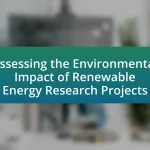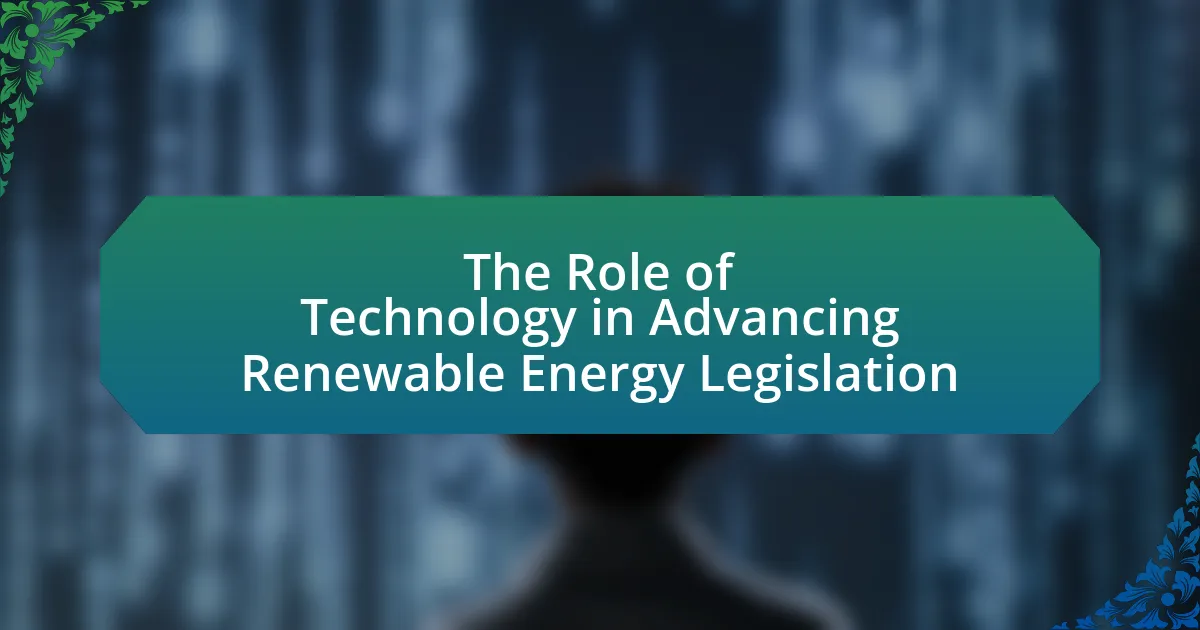The article focuses on the critical role of policy in accelerating the adoption of renewable energy. It outlines how regulatory frameworks, financial incentives, and support mechanisms foster investment in clean energy technologies, highlighting successful examples from countries like Germany and the United States. Key topics include the effectiveness of subsidies and tax incentives, the impact of government mandates on renewable energy growth, and the importance of international agreements in shaping national policies. Additionally, the article discusses challenges faced by the renewable energy sector without supportive policies and offers insights into best practices for implementing effective renewable energy strategies.

What is the Role of Policy in Accelerating Renewable Energy Adoption?
Policy plays a crucial role in accelerating renewable energy adoption by establishing regulatory frameworks, financial incentives, and support mechanisms that promote clean energy technologies. For instance, government policies such as feed-in tariffs, tax credits, and renewable portfolio standards create a favorable environment for investment in renewable energy projects. According to the International Renewable Energy Agency (IRENA), countries with supportive policies have seen a significant increase in renewable energy capacity; for example, Germany’s Energiewende policy led to a more than 40% share of renewables in its electricity generation by 2019. These policies not only reduce the cost of renewable technologies but also stimulate job creation and economic growth in the clean energy sector.
How do policies influence the growth of renewable energy sectors?
Policies significantly influence the growth of renewable energy sectors by establishing regulatory frameworks, financial incentives, and market conditions that promote investment and development. For instance, government mandates for renewable energy usage, such as renewable portfolio standards, require utilities to obtain a certain percentage of their energy from renewable sources, thereby driving demand. Additionally, financial incentives like tax credits and subsidies lower the cost of renewable energy projects, making them more attractive to investors. According to the International Renewable Energy Agency (IRENA), countries with supportive policies saw a 50% increase in renewable energy capacity from 2010 to 2019, demonstrating the direct correlation between policy support and sector growth.
What types of policies are most effective in promoting renewable energy?
Subsidies and tax incentives are the most effective policies in promoting renewable energy. These financial mechanisms lower the cost of renewable energy technologies, making them more competitive with fossil fuels. For instance, the U.S. federal Investment Tax Credit (ITC) has significantly boosted solar energy installations, contributing to a 167% increase in solar capacity from 2016 to 2020. Additionally, feed-in tariffs guarantee fixed payments for renewable energy producers, ensuring a stable revenue stream that encourages investment. Countries like Germany have successfully implemented such tariffs, leading to a rapid expansion of their renewable energy sector.
How do government incentives impact renewable energy investments?
Government incentives significantly enhance renewable energy investments by reducing financial risks and improving project viability. These incentives, such as tax credits, grants, and subsidies, lower the overall cost of renewable energy projects, making them more attractive to investors. For instance, the Investment Tax Credit (ITC) in the United States allows investors to deduct a percentage of the investment cost from their federal taxes, which has been instrumental in driving solar energy growth. According to the Solar Energy Industries Association, the ITC contributed to a 167% increase in solar capacity from 2016 to 2020. Thus, government incentives create a favorable investment climate, leading to increased capital flow into renewable energy sectors.
Why is policy essential for renewable energy transition?
Policy is essential for the renewable energy transition because it establishes the regulatory framework and incentives necessary to promote investment and innovation in clean energy technologies. Effective policies, such as subsidies for renewable energy projects and mandates for renewable energy usage, drive market demand and lower costs through economies of scale. For instance, the International Renewable Energy Agency reported that countries with supportive policies saw a 20% increase in renewable energy capacity from 2010 to 2019, demonstrating the direct impact of policy on accelerating adoption.
What challenges does the renewable energy sector face without supportive policies?
The renewable energy sector faces significant challenges without supportive policies, including limited investment, slow technological advancement, and market instability. Without government incentives or regulations, private investors are less likely to fund renewable projects, leading to insufficient capital for development. For instance, a report by the International Renewable Energy Agency (IRENA) indicates that investment in renewable energy technologies dropped by 8% in 2020 due to uncertain policy environments. Additionally, the absence of supportive frameworks can hinder innovation, as companies may lack the motivation to develop new technologies without guaranteed market access or financial support. Furthermore, market instability arises from fluctuating energy prices and competition from fossil fuels, which can undermine the competitiveness of renewable energy sources. Overall, these challenges collectively impede the growth and adoption of renewable energy solutions.
How do policies help in overcoming barriers to renewable energy adoption?
Policies help in overcoming barriers to renewable energy adoption by providing regulatory frameworks, financial incentives, and support mechanisms that facilitate investment and deployment. For instance, government policies such as feed-in tariffs and tax credits lower the cost of renewable energy projects, making them more attractive to investors. According to the International Renewable Energy Agency (IRENA), countries with supportive policies have seen a 50% increase in renewable energy capacity over the last decade. Additionally, policies that streamline permitting processes reduce bureaucratic hurdles, enabling faster project implementation. Thus, effective policies directly address economic, regulatory, and logistical barriers, promoting a more favorable environment for renewable energy adoption.
What role do international agreements play in shaping renewable energy policies?
International agreements play a crucial role in shaping renewable energy policies by establishing frameworks for cooperation, setting targets, and promoting best practices among nations. These agreements, such as the Paris Agreement, compel countries to commit to specific emissions reduction goals, thereby incentivizing the development and implementation of renewable energy technologies. For instance, the Paris Agreement aims to limit global warming to well below 2 degrees Celsius, which drives nations to transition from fossil fuels to renewable sources like solar and wind energy. Additionally, international agreements facilitate financial and technical support for developing countries, enabling them to adopt renewable energy solutions more effectively. This collaborative approach not only fosters innovation but also aligns national policies with global sustainability objectives, ultimately accelerating the transition to renewable energy.
How do global climate agreements influence national policies on renewable energy?
Global climate agreements significantly influence national policies on renewable energy by establishing binding targets and frameworks that countries must adhere to. These agreements, such as the Paris Agreement, compel nations to commit to reducing greenhouse gas emissions, which often leads to the development and implementation of policies promoting renewable energy sources. For instance, countries that ratified the Paris Agreement are encouraged to set nationally determined contributions (NDCs) that include specific renewable energy goals, thereby driving investments in solar, wind, and other sustainable technologies. This alignment with international standards not only fosters domestic policy changes but also attracts funding and technological support from global initiatives aimed at combating climate change.
What are the implications of international cooperation on renewable energy adoption?
International cooperation significantly enhances renewable energy adoption by facilitating technology transfer, funding, and shared best practices among nations. Collaborative efforts, such as the Paris Agreement, encourage countries to commit to emission reduction targets, thereby fostering investment in renewable technologies. For instance, the International Renewable Energy Agency reported that global renewable energy capacity reached 2,799 gigawatts in 2020, largely due to international partnerships and investments. These collaborations not only accelerate the deployment of renewable energy projects but also promote innovation through shared research and development initiatives, ultimately leading to a more sustainable energy future.
How can policies be designed to enhance renewable energy adoption?
Policies can be designed to enhance renewable energy adoption by implementing financial incentives, regulatory frameworks, and educational initiatives. Financial incentives, such as tax credits and subsidies, lower the cost barrier for consumers and businesses, encouraging investment in renewable technologies. Regulatory frameworks, including renewable portfolio standards and feed-in tariffs, create a stable market environment that promotes the growth of renewable energy sources. Educational initiatives raise public awareness about the benefits of renewable energy, fostering a culture of sustainability. For instance, countries like Germany have successfully increased renewable energy adoption through a combination of these policy measures, resulting in over 40% of their electricity coming from renewable sources by 2020.
What are the best practices for implementing effective renewable energy policies?
Effective renewable energy policies should prioritize clear regulatory frameworks, financial incentives, and stakeholder engagement. Clear regulatory frameworks provide stability and predictability, which are essential for attracting investment in renewable energy projects. For instance, countries like Germany have successfully implemented feed-in tariffs that guarantee fixed payments for renewable energy producers, leading to significant growth in solar and wind energy sectors.
Financial incentives, such as tax credits and subsidies, further encourage the adoption of renewable technologies. The U.S. Investment Tax Credit (ITC) has been instrumental in boosting solar energy installations, with a reported increase of over 10,000% in solar capacity since its introduction in 2006.
Stakeholder engagement, including collaboration with local communities, businesses, and environmental groups, ensures that policies are socially acceptable and effectively address local needs. Research by the International Renewable Energy Agency (IRENA) indicates that inclusive policy-making leads to higher public support and smoother implementation of renewable energy initiatives.
These best practices collectively enhance the effectiveness of renewable energy policies, driving the transition towards sustainable energy systems.
How can stakeholder engagement improve policy outcomes for renewable energy?
Stakeholder engagement can significantly improve policy outcomes for renewable energy by ensuring that diverse perspectives are considered in the decision-making process. Engaging stakeholders, including local communities, industry experts, and environmental groups, fosters collaboration and builds trust, which can lead to more effective and widely accepted policies. For instance, a study by the International Renewable Energy Agency (IRENA) found that inclusive stakeholder processes can enhance policy legitimacy and increase public support for renewable energy initiatives, ultimately resulting in higher adoption rates and successful implementation of renewable energy projects.
What metrics should be used to evaluate the success of renewable energy policies?
The metrics used to evaluate the success of renewable energy policies include greenhouse gas emissions reductions, renewable energy capacity installed, energy cost savings, job creation in the renewable sector, and energy access improvements. Greenhouse gas emissions reductions measure the effectiveness of policies in lowering carbon footprints, while renewable energy capacity installed indicates the growth of renewable sources in the energy mix. Energy cost savings reflect the economic benefits to consumers and businesses, and job creation highlights the impact on employment within the renewable sector. Lastly, energy access improvements assess how policies enhance energy availability, particularly in underserved communities. These metrics provide a comprehensive framework for assessing the overall effectiveness and impact of renewable energy policies.
What future trends in policy could further accelerate renewable energy adoption?
Future trends in policy that could accelerate renewable energy adoption include increased government incentives for clean energy technologies, stricter emissions regulations, and enhanced support for research and development. These policies can drive investment in renewable energy by making it more financially attractive for businesses and consumers. For instance, countries that have implemented feed-in tariffs or tax credits for solar and wind energy have seen significant growth in renewable capacity; Germany’s feed-in tariff policy led to a tenfold increase in solar energy production from 2000 to 2015. Additionally, international agreements like the Paris Agreement encourage nations to commit to renewable energy targets, fostering a global shift towards sustainable energy sources.
How might technological advancements influence future renewable energy policies?
Technological advancements will significantly shape future renewable energy policies by enabling more efficient energy production and storage solutions. For instance, innovations in solar panel efficiency and battery technology can lead to reduced costs and increased adoption rates, prompting policymakers to create incentives for these technologies. The International Renewable Energy Agency reported that the cost of solar energy has dropped by 89% since 2009, illustrating how advancements can drive policy changes that support renewable energy integration into national grids. Consequently, as technology evolves, policies will likely adapt to promote sustainable practices, enhance grid resilience, and facilitate the transition to a low-carbon economy.
What role will public opinion play in shaping future renewable energy policies?
Public opinion will significantly influence future renewable energy policies by driving political agendas and shaping legislative priorities. As public awareness of climate change and environmental issues increases, policymakers are more likely to respond to constituents’ demands for sustainable energy solutions. For instance, a 2021 survey by the Pew Research Center found that 79% of Americans support expanding solar panel farms, indicating a strong public preference for renewable energy initiatives. This widespread support can lead to the implementation of policies that promote investment in renewable technologies, incentivize clean energy production, and facilitate the transition away from fossil fuels.
What practical steps can policymakers take to support renewable energy adoption?
Policymakers can support renewable energy adoption by implementing financial incentives, such as tax credits and subsidies, to lower the cost of renewable technologies. For instance, the Investment Tax Credit (ITC) in the United States has significantly boosted solar energy installations by allowing investors to deduct a percentage of the cost of solar systems from their federal taxes. Additionally, establishing renewable energy standards can mandate a certain percentage of energy to come from renewable sources, driving investment and development in the sector. Countries like Germany have successfully utilized feed-in tariffs to guarantee fixed payments for renewable energy producers, ensuring a stable revenue stream that encourages growth. Furthermore, investing in infrastructure improvements, such as smart grids and energy storage systems, enhances the reliability and efficiency of renewable energy sources, facilitating their integration into existing energy systems.



